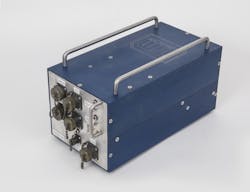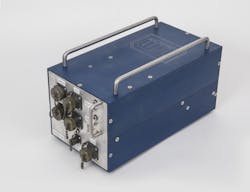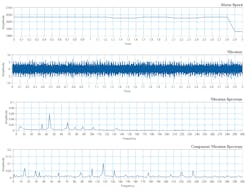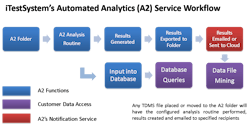Feeding the Next Generation of Product Development
Today’s accelerated product development processes rely heavily on real-world operating data in order to analyze computer-generated prototypes in the early upstream stages. This has a number of advantages, including the ability to quickly and inexpensively validate a design or evaluate a greater number of design alternatives.
Additionally, such information allows designers to choose the materials and design features so that products and/or their components are neither under- nor over-designed. This ensures that products are properly designed, are manufactured as inexpensively as possible, and are of acceptable quality levels as to limit warranty claims and liability. Put simply, historical usage data serves as a simulation benchmark on how products will perform under normal real-world conditions. But what exactly is normal?
Challenges
Once in the hands of consumers, products are often subject to conditions outside of their intended design. Consequently, next-generation products must be designed to account for a number of unanticipated stresses, strains, and events. For example, a truck designed solely for on-road applications might be put to work in some harsh off-highway conditions.
In one such case, tractor trailers designed and manufactured to meet rather consistent on-road driving conditions can be seen careening down the dirt roads of Central America sugar cane plantations—a scenario for which the truck was neither intended nor designed. Similarly, engine mounts, couplings, mirrors, windshields, and other components are designed to withstand certain levels of vibration; but to what level of loads and forces are they subjected under such abnormal conditions?
What about an offshore oil platform? How might the structure be impacted by the pounding of the rogue wave or collision with a runaway barge? Capturing data over an extended period (generally weeks or months) ensures that an ample amount of information is acquired to account for extreme conditions or even the elusive anomaly.
Because it’s never known when an event outside of the normal range will occur, the product, equipment, structures, etc. must be monitored (or have the ability for data to be collected) around the clock. Needless to say, this can be a costly proposition and isn’t always practical—or even possible. Hard-to-access components or equipment in remote or harsh locations offer some unique challenges; yet these are often the very types of products/components with excessively high failure rates.
Solution: Unattended Testing
For all its advancements, the challenge that the testing community has long faced has been with observing the normal daily operation of a product in its natural environment over an extended period—a process that includes the collection of massive amounts of data. After all, physically manning test equipment all day every day simply isn’t realistic.
A new approach to field testing and data acquisition—whether the product is miles off-shore, clearing a remote mountain pass, or inside the transmission of a car speeding down the highway—provides access to a far more complete picture of the actual conditions, stresses, and events that lead to failures. Finally, high-volume, high-quality, high-resolution customer usage data can be readily collected, analyzed, and used to ensure the development of more durable and reliable products.
With ITM’s RAC-88 ruggedized data acquisition hardware and iTestSystem software, remote structures and machinery can be monitored around the clock.
In the past testing was limited to collecting only low frequency data. Today, one might need to sample at rates of 5,000 Hz (or 5,000 data samples per second) or faster. Now employing an unattended testing approach, a tremendous amount of data can be sampled, between 30 to 1,000-plus channels, over weeks or months and stored on the equipment for analysis.
This has ramifications throughout a wide variety of industries: off-highway, construction, aerospace, transportation, medical, and so on. In fact, it’s difficult to imagine an industry where unattended testing will not have an impact.
As an example, the recent announcement of tighter Tier 4 Emission Standards sent the off-highway industry scrambling for answers.
- How are exhaust treatment systems best mounted on equipment?
- Will the design/structure withstand long-term engine vibration and operating conditions?
- What is the normal and extreme range of conditions to which the exhaust treatment system be subjected?
- To what degree will electronic components withstand vibration?
Because engines and electronic emission control components are subject to different environmental, operating, and vibrations, a way was needed to determine the best design for mounting the emission control system to the engine. Accurate long-term field data was needed to create baseline data for simulation, laboratory, mass table testing,, and accelerated testing. This proved to be an excellent application for unattended testing. With this detailed information, off-highway manufacturers can incorporate the necessary changes to meet rigid emission standards without introducing new mechanical problems.
Driving Technology
In the past, long-term unattended data collection was not limited by hardware. A number of rugged, portable, and compact data recording systems have been available for some time now. Rather, the issue was with software and data access. Limited storage meant that long-term testing required constant data downloads. This could mean continually interrupting operation and/or frequent and costly on-site visits by engineers or technicians to download the data and check to ensure that quality data is being captured.
Simply turning on the hardware to record data without managing it will create an unmanageable overflow of data. Fortunately, advanced unattended testing technologies have emerged to provide automated test management and remote data access.
iTestSystem allows structural and vibration data to be remotely captured and analyzed from equipment in its natural environment.
iTestSystem is an example of one software suite ITM is developing to enable test engineers to organize, acquire, view, and analyze important engineering data. It is important to find software that collects, analyzes, and trends data from sensors connected to their products and processes. This ability allows failures to be predicted, operating conditions to be evaluated, and vibration levels determined.
Added features include support for additional data acquisition hardware along with advanced event triggering functionality. These and other functions give engineers a tool to collect, analyze, and trend data from sensors connected to their products and processes, enabling them to predict failures, evaluate operating conditions, and determine vibration levels.
Comprehensive Data Collection
It is key that unattended testing components collect data at regular intervals. This can occupy a lot of disk space, and limit the time a device can collect data. There are features available that only trigger data capture when certain conditions are met, and only during times when the system is active. This ensures that anomalies and other key events are captured and made available to the test engineer without wasting disk space.
iTestSystem Automated Analytics workflow is used for inserting data to a database or sending data to remote users.
Employing sophisticated testing software lets system capture and stream data to a portable USB hard drive while on-board analytics generate results and distribute them to specified recipients. Within minutes of a data set being recorded results can be viewed or downloaded on a PC or mobile device. Allowing data to be remotely accessed, downloaded, and checked provides a whole new level of visibility and control. Furthermore, the two-way communication process allows testing to be modified without visiting the site or interrupting the operation.
Putting the Data to Work
When testing a new line of products, the manufacturer might want field data information to enhance the design of a particular component. Hundreds of thousands of data points can be reduced from weeks of testing into a report that allows the manufacturer to quickly see rare events such as off-the-charts vibration levels that could potentially cause a failure. These events can be isolated in time so engineers can interrogate any of a hundred other recorded channels and explore exactly what else was occurring in relationship to the product to help pinpoint the problem.
Real-world operating data, collected in a product’s natural environment, continues to be the best source of baseline information needed to validate designs. Simulation applications allow designers to quickly and accurately evaluate a large number of design alternatives while ensuring that durability, quality, production, and time-to-market targets will be met.
This process is critical to ensure that components, sub-assemblies, and assemblies are designed to meet the requirements for which they are intended and guard against over-design (resulting in excess material, weight, and cost) or under-design (leading to failure, safety issues and excessive warranty claims).
For manufacturers and suppliers in the off-highway equipment industry, extended data sample sets provide a far more accurate representation of how a product will react to forces, vibrations, heat, fatigue, and the occasional anomaly than data collected through a tight window. Unattended testing provides the solution to capturing the quantity and quality of data needed to drive today’s accelerated product development processes.
Conclusion
To avoid excessive warranty claims, quality issues, and lost market share, next-generation products must be designed to meet demands beyond the product’s intended use. In order to do this, it’s important that designers and manufacturers have an accurate understanding of the usage parameters to which products are often subjected.
Unattended data acquisition and analysis provides the ability to gather, process, and interpret terabytes of data captured during month-long, high-frequency tests of equipment on the fly. As a result of these deep-dive testing and analysis methods, manufacturers are gaining invaluable snapshots of in the field stresses that can then be used to troubleshoot equipment failures, tweak product designs, or even adjust validation tests to more accurately reflect real world environments.
This long-term approach provides a far more complete picture of the actual environment and stresses to which products may be subjected. Armed with this information designers can better quantify and predict future performance and develop products that satisfy the complete range of actual customer usage.
Tim Carlier is president of Integrated Test & Measurement. He can be contacted via e-mail.




